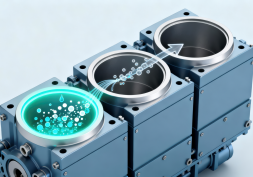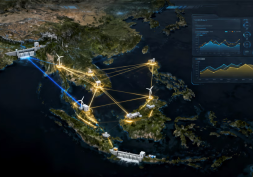Giving robots a sense of touch
Follow CDE
PDF Download

An E-Skin that combines optimised tactile sensors with deep-learning algorithms achieves tactile perception surpassing that of the human somatosensory system, advancing applications in robotics and wearable devices for healthcare and rehabilitation.
How sensitive are you? According to research, extremely. Our sense of touch is so refined that we can feel the difference of just a single layer of molecules. And although we might not realise it, the human body can perceive a temperature change as small as one degree Celsius.
These sensational sensory capabilities would surely make cold, mechanical robots flushed with jealousy.
But not for long. Robots are getting a new skin. At the Department of Electrical and Computer Engineering, College of Design and Engineering, National University of Singapore, Associate Professor Vincent Lee Chengkuo and his team have developed a novel electronic skin (E-Skin), powered by a digital brain, that surpasses the tactile perception of the human somatosensory system. This could mean better, more effective cognitive robots for applications in healthcare and rehabilitation.
The team’s research was published in Advanced Materials on 11 August 2024.
Together with his team, Associate Professor Vincent Lee Chengkuo designed a novel electronic skin that surpasses the tactile perception of the human somatosensory system.
Bestowing the human touch upon robots
Creating an E-skin that can rival its human counterpart has long been a challenge as replicating multimodal tactile perception in a single, compact device is very complex. Existing devices often integrate multiple sensors to detect various stimuli, such as temperature, pressure and texture — leading to overly complicated designs, signal inaccuracies and exorbitant costs.
Simplicity is what robots are after. The NUS team’s E-Skin is composed of just two advanced sensors: the transient voltage artificial neuron (TVAN) and the sustained potential artificial neuron (SPAN).
The TVAN detects dynamic tactile stimuli, such as vibration, texture and material, using a triboelectric-based mechanism that generates electrical signals in response to mechanical interactions with surfaces. The sensor takes the form of a honeycomb, which makes it more sensitive to different textures and materials — much like how our fingerprints can tease out subtle surface changes.
The SPAN, on the other hand, is an ionic hydrogel-based sensor designed to measure static tactile information, such as pressure and temperature. Unlike conventional sensors, the SPAN generates its own voltage without requiring an external source, reducing energy consumption and simplifying its design, making it suitable for applications that require continuous monitoring.
“By integrating the TVAN and SPAN into a single unit, our E-Skin converts detected physical stimuli into electrical signals, while machine-learning algorithms make sense of these signals to determine an object’s texture, roughness, hardness, material and temperature,” says Assoc Prof Lee. “Machine learning also helps mitigate the challenges of signal interference and variability in real-world applications, compensating for inconsistencies in applied force, speed and environmental conditions.”
Super-sensitive touch
Wrapping their E-Skin around a robotic finger, the researchers put it to the test — and the results were far from skin-deep.
With an accuracy of 91.2%, the device could differentiate the roughness of ten surfaces, ranging from textures ten times smoother than a strand of human hair to as coarse as a grain of rice.
It also detected eight levels of hardness, from the softness of foam to the rigidity of glass, with 99.5% accuracy. The impressive results go on: the E-Skin can distinguish 16 objects across varying temperatures with 98.5% accuracy; identify 15 different individuals with 97.8% accuracy; classify 16 different fruits with 99.0% accuracy; and detect specific temperatures with an average accuracy of 98.9%.
"E-Skin will be essential in future smart homes and smart cities, providing better and more comprehensive care for the elderly."
"E-Skin will be essential in future smart homes and smart cities, providing better and more comprehensive care for the elderly."
A sense of urgency
The team’s scalable, versatile E-Skin technology offers a range of applications to support healthcare operations, particularly in enhancing elderly care as tactile sensitivity declines with age. This technology can improve touch-based diagnostics and enable robots to perform tasks requiring precise, gentle handling.
“E-Skin will be essential in future smart homes and smart cities, providing better and more comprehensive care for the elderly. For example, embedding this technology in everyday items, including walking sticks, bedding or chair cushions, would allow closer monitoring of the health and activity of older persons,” says Assoc Prof Lee.
"E-Skin will be essential in future smart homes and smart cities, providing better and more comprehensive care for the elderly."
This is especially pertinent against the backdrop of an ageing global population that requires more care and a healthcare system already beset by workforce shortages, capacity snags and fragmentation.
“Telemedicine systems can also benefit from this E-Skin technology. Doctors would be able to monitor physiological parameters and skin conditions remotely — ensuring timely medical care while reducing the need for frequent clinic visits,” adds Assoc Prof Lee.
Read More
View Our Publications ▏Back to Forging New Frontiers - October 2024 Issue
If you are interested to connect with us, email us at cdenews@nus.edu.sg









